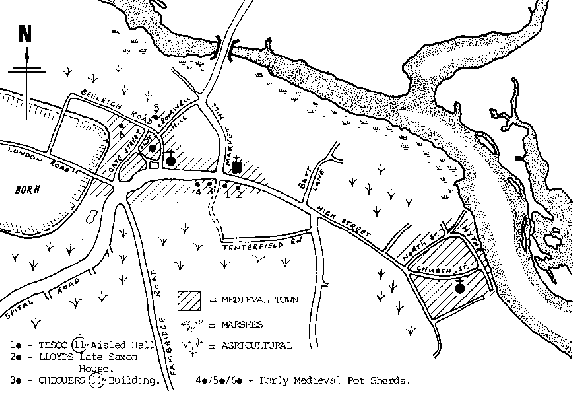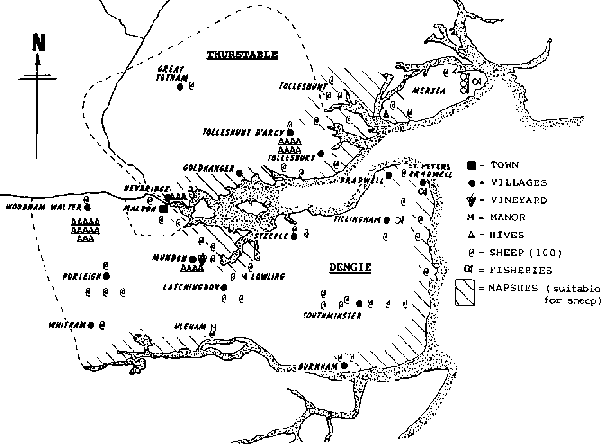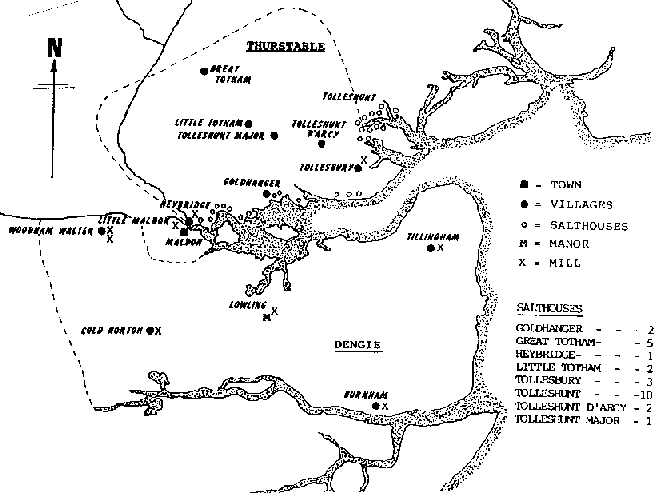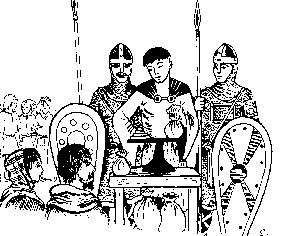Maeldune - Light on Maldon's Distant Past
Patricia Sheehy
1066 AND ALL THIS
THE events of 1066 are among the most well known in English history. On the death of Edward the Confessor, early in the new year, Harold Godwinson, Earl of Wessex and Duke William of Normandy both felt they had a legitimate claim to the throne. Being well aware of the Norman threat to English sovereignty, the nobility was quick to crown Harold king. A challenge from William was inevitable so Harold, support by church and state, soon set about organising an army and fleet to defend the south-east coast.
During a long wait for the Norman ships, which were delayed by unfavourable winds, Harold had other serious problems to deal with. On 24th September he rushed his depleted army up to Stamford Bridge in Yorkshire and won a famous battle against the combined forces of Tostig, Harold's own brother, and Hardrada of Norway. Days afterwards, news arrived that William had landed at Pevensey, forcing Harold to march his weary army back south to Hastings. Both armies engaged in battle on the 16th October.
By evening Harold was dead and with him the old social order and in its place the new hierarchy based on feudalism.
AFTER 1066
After 1066 the English Thanes were rarely heard of and by 1087 only a small number had managed to retain their own land. Some were killed at the Battle of Hastings and subsequent rebellions, others fled to Scotland or abroad, but many became the tenants of the new Norman Barons.
The Thane was appointed to public office by the English king to administer justice, keep the peace, answer the call to arms and to carry out some services like repairing roads and bridges. These posts never became hereditary but the holder was invested with public authority and personal influence over his vassals. The Thane would lease his lands for rent or service to vassals who had placed themselves under his protection thus building a bond of allegiance between them. This type of loyalty is described in the poem of Maldon as men rushed to Brythnoth's side after his call to arms.
The Norman nobility's land tenure was based on the fief. This was an estate which was held on condition of military service to the bestower, usually King William, although other high ranking barons and the Church could convey a fief to a knight. The barons held the same jurisdiction rights as their predecessors. The legal, civil and monetary systems remained unchanged, but whereas previously the nation's business was conducted in official English it was now done in Latin, a language few of the Saxons or the barons could read.
The lower strata of society remained exclusively Saxon, there was little or no change to their lives, they simply changed masters. The coming of the Normans simplified and reduced the many ranks of English society. The serf class became much smaller because another class of people were now doing their work, indicating that the social standing of some had declined. The highest position that free English men could attain was either as a reeve, a collector of dues, or as a forester because of his knowledge of the land. Even the church would not allow Englishmen to hold high office.
Maldon - The Town
Before the Conquest, Maldon was the second biggest town in Essex after Colchester, possessing a burh, mint, port and probably a market place. During the early decades of the 11th century, Maldon grew in prosperity but then suffered a decline from which it slowly recovered.
The overseas trade at that time was with the Scandinavian countries and Flanders, but after 1066 England's new trading partners became the people of the French mainland. No new economic or administrative changes were brought about with the change of rulers and Maldon remained the centre of commerce and jurisdiction for the surrounding countryside.
The Domesday Book shows us that Maldon was a borough with about 200 houses, of which 18 were described as in a ruinous state. All of them were owned by the king and rented to the burgesses (freemen of a borough) for either money or military services.
Although the burgesses did not need to live in the town they were responsible for the customs such as the ?20 tax on the Mint. They made sure that the King received his monetary dues on a regular basis and when Peter the Sheriff collected the money he was most careful to weigh the coinage as a measure against the illegal activity of clipping small pieces of silver from the coins. Another custom imposed on the town and its people was the military obligations to provide a horse and a ship.
The mint was carrying on business as usual. The moneyer, usually a person of some wealth and power, was responsible for the reliability of the coins he produced and if anything was wrong the law would deal severely with him.
The churches of Maldon were not mentioned in the Book, as they were too poor to tax, but they were probably ministered to by Saxon priests in buildings constructed of timber and thatch. It is a feature of Essex towns that the parish church and the market place were situated outside the burh fortifications. At Maldon, All Saints church and the old market place both appear to lie outside the earthen banks associated with the Saxon Burh.

The opportunity to uncover archaeological finds belonging to the early medieval period has been limited to rescue excavations. Prior to the Lloyds Bank construction in the High Street the site was excavated by archaeologists in 1978. Two phases of domestic buildings came to light, one belonging to the Late Saxon Period was built at right angles to the High Street with a series of back yard drainage ditches linked to a well or sump. Also found were some pits and masses of rubbish comprising of broken pots, bones belonging to sheep, pigs, goats, birds, fish, cows and horses. The broken pots were of the types which originated from St Neots and Stamford as well as these which were locally made. The Lloyds Bank site appears to mark the eastern limits of medieval Maldon before it expanded towards the Hythe.
In 1971/72 excavation by Essex Archaeological Society at 62 High Street (site of Maldon's first Tesco Supermarket and now occupied by Iceland Freezer Food) revealed a timber building of the 10th century fronted on to the present High Street, with dimensions of 11m by 6m, it had a well laid gravel floor. This floor was covered with charcoal debris associated with some form of occupation plus the familiar St Neots and Stamford pot sherds.
The next building to be erected on this site was a mid 11th century aisled hall of the same size. This Norman house may have had a sandstone floor as some paving slabs were found as infill of a later trench elsewhere on the site. For some reason the slabs were not down for long as 11th century debris was scattered over an underlying rough surface. This building has a small back yard with a well which the householders used for their water supply. The recently demolished Chequers Public House also showed signs of 11th century construction as evidenced by a road side ditch and timber slots excavated by the E.C.C. and M.A.G. archaeologists. Other sites which have yielded early medieval finds have been at the back of Boots Chemist when a new extension unearthed 2 pot sherds; an array of sherds dating from the 10th to 16th century were found at the Maldon Court School and some Late Saxon pottery found in Beeleigh Road.
It is believed that the population of Maldon in 1087 was approximately 1100, although very few people are mentioned in the Domesday Book. Compared to Colchester, the entry for Maldon does not have the extensive list of names or the acreage needed to support them and their families. It does state though that occupiers of 15 houses in the town had a reasonable amount of land of over 0.5 a hide (60 acres), while the other men had only their houses. But these men appear to have owned between them 12 horses, 140 cattle, 103 pigs and 336 sheep so it is probable that they had land or access to common land.
The townsfolk may have been made up of tradesmen, merchants and craftsmen with some smallholders, freemen, villagers and a small number of slaves. Wealthier individuals would have resided in halls similar to that found on the Tesco site but the majority would have lived in one roomed timber and wattle cottages along with their own peasant farm animals.
There was not a great deal of variety in the people's diet, it was governed by the seasons and the only means of preserving food was to salt it. The staple food was barley bread supplemented by a little mutton, cheese, a few vegetables and salted herrings. In the Autumn fruits and nuts were collected from the hedgerows but the wild animals of the fields were out of bounds as they belonged to the new Norman Lords. To wash this meagre diet down there was either ale, cider or the less preferred water. The selection of foods for the richer citizens of Maldon included bread made from wheat, fish, and meat consisting of either beef, rabbit or venison.
The clothes at that time were of wool in colours of greens, browns and russets. Most of the men wore close fitting leggings and a knee length tunic pulled in at the waist by a belt; a large cloak to go over the top of these garments was common place in winter. The women wore long dresses and a cloak fastened with a brooch and, if skilled with the needle, the women would have embroidered parts of their dresses for that individual touch.
Apart from the people whose occupation were of a mercantile or industrial nature, most of the inhabitants of Maldon and the surrounding areas were engaged in agriculture. Although the land was owned by Normans, the people who worked the soil were the English, usually referred to as villagers, smallholders or bordars.

There was a mixed form of husbandry in medieval times because the land was classified as either meadow, pasture, woodland or arable. The woods supported many pigs, and were a source of fuel and building materials. Cattle and sheep grazed in the meadows and pastures. The total number of sheep in the Maldon and Dengie area ran into many thousands. Northey Island supported a large number and there were approximately 1200 on the Southminster manor. Altogether the Thurstable and Dengie Hundreds appear to have had approximately 7500 sheep recorded in the Domesday Book.
What made this part of England so beneficial for sheep rearing was the large area of marsh which proved to be such good grazing land even though it was under water part of the year. Apart from their wool, a vast amount of cheese was produced in dairies called in those days 'wicks'. A name which can still be found on modern maps is Maldon Wick.
Numerous meadows next to the Blackwater were, like the marsh, under water for part of the year, except that these produced hay in summer and could later be grazed by the animals.
In the Domesday Book, arable land was described as a number of ploughs, which is believed to have meant the acreage of land which could be ploughed by one team of 8 oxen in a given time. Not all plough teams were of 8 oxen, more usually they were less, occasionally more, and it was not unusual to find a mixed team of oxen and horses pulling the plough. Near the town or village there would have been two large fields, one laying fallow and the other divided up into strips so that each person would receive a mixture of fertile and poor soil. The crops grown were oats, barley and rye; the vegetables produced were peas, onions and leeks, and enough had to be grown to provide food during the year and seed for the next.
A mill at the Little Maldon manor owned by Ranulf Peverel was most certainly used by the local farmers for grinding corn. Other mills were recorded at Heybridge, Woodham Walter, Lawlings and Burnham all sited next or close to rivers indicating that the mills were powered by water.

One of the local trades was salt panning due to the marshes naturally concentrating the salt in the sea water. The salt houses were at Goldhanger, the Tolleshunts and Tollesbury, and one would have been at Salcot as the name implies, though Salcot is not recorded in the Domesday Book. The locals would have collected the brine water from the marshes and evaporated it in large dishes over fires to get the finished product of crystal salt. From the salt houses this valuable product would have been transported inland to the markets for sale, a sizable amount being sold to the Maldon and Dengie Wicks as a vital ingredient for cheese making.
Another important industry based around the town and rivers was fishing. Fisheries were recorded at East Mersea, Tollesbury and Tillingham.
Maldon - The People
For the Domesday Book, King William sent commissioners into the Shires to record all land which could be taxed. It was the land of the wealthy and not the Saxon peasant that was recorded, together with their salthouses, mills and fisheries. Hence it is only the Norman barons and their tenants who are mentioned in the Book, other members of society were classed as villager, freeman, smallholder or slave. The Domesday Book does have the names of the people who were lords of the manor before 1066 as well as the names for 1086 and it shows how complete the take over of ownership by the Normans was.
At the time of the Conquest one of the most powerful men in Essex was Sigeweard of Maldon. He owned estates at Little Maldon, Down Hall, Tolleshunt D'Arcy and Woodham Mortimer and he leased land in Tollesbury from St Mary of Barking. At that time the English Thanes had a strong influence on the administration of the county and its courts and Sigeweard was no exception. The Hundreds of Uttlesford and Dengie had to be divided up to prevent him from exercising too much power because of the area's strategic importance.
The Norman successor to Sigeweard was Ranulf Peverel who received all his manors. Another English landowner mentioned in the Domesday Book was Gudmund, brother to Wulfric, Abbot of Ely. Gudmund's manor in Tollesbury went into the hands of Count Eustace.
Any small English landowners after the Conquest soon had their Norman neighbours encroaching on to their property. By far the largest owner of land was Ranulf Peverel with a total of 11 manors, from Woodham Mortimer in the west to Down Hall in the east, yet most of his manors were within 5 miles of Maldon. Peverel was worth over ?80, a large sum of money in those days. For all his wealth and the power associated with such possessions, history books do not record that he was an influential man of his day. It appears that his descendants all died out within a couple of generations and the manors reverted back to the Crown.
Swein of Essex, the second largest landowner in Essex, was a relative of both William and Edward the Confessor and like his father before him he was the Sheriff of Essex. He was responsible for collecting the royal revenues, that is money from the courts and the customs from the boroughs and royal estates. Although his father was the Sheriff it was not a hereditary title and he would have been appointed by the King. Swein's estates included Iltney, East Mersea, Tollesbury, Little Totham and a manor in Maldon. It was his duty to provide the other burgesses with a ship as ordered by the King, so perhaps Swein owned part of the river front with a boatyard or he may have owned some ships.
The church owned huge estates in the Dengie peninsular most of which had been given by the nobility. The Bishop of London appears to have owned land in his own right as Bishop rather than on behalf of the Church and he is recorded as owning the manor of Southminster which also included the parishes of Mayland and Althorne. Often land left to the Church found its way back into the hands of the nobility and this happened to Southminster when Cnut seized it during his reign. The Bishop finally regained his manor from Edward the Confessor.
At the start of William's reign there was a general decline in the value of land. This had not greatly improved by 1086 except on most of the manors owned by the Church, where the value had increased, sometimes double the original figures. Only the Bishop of London seems not to have done so well. The Domesday Book mentions the acreage of ploughed land belonging to both lord and men during the years of 1066 and 1086. It is notable there was a marked decline in the ploughed fields cultivated by the men (Saxon), and a marked increase in land ploughed by the Norman Barons, a graphic illustration of the social changes of the period.

| Mealdune Contents | Maldon Archaeological Reports Home | Next section..... |
